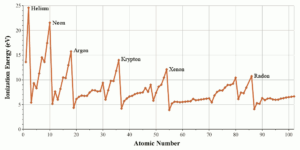Table of Contents
Ionization Energy
In basic words, ionization energy is a measure of how difficult it is to remove an electron from an atom or ion, or how likely an atom or ion is to yield an electron. In most cases, one electron is lost in the chemical species’ ground state.
We may also say that ionization, or ionization energy, is a measure of the strength (attractive forces) with which an electron is held in place.
What is the definition of ionization energy?
In more technical terms, ionization energy is the lowest amount of energy that an electron in a gaseous atom or ion must receive to escape the nucleus’ influence. It’s also known as ionization potential, and it’s often an endothermic process.
We may also conclude that ionization energy provides us with a sense of a chemical compound’s reactivity. It may also be used to determine the strength of chemical bonds. It can be expressed in electronvolts or kJ/mol units.
Ionization energy can be either adiabatic ionization energy or vertical ionization energy, depending on the ionization of molecules, which typically results in changes in molecular geometry.
Ionization Energy Controlling Factors
It is usually more difficult to remove one electron when the ionization energy is large. A lot of factors have a role in the attraction forces.
- If the nucleus is positively charged, electrons are strongly drawn to it.
- The attraction between an electron and the nucleus is greater when the electron is close to or near the nucleus.
- When there are more electrons between the outer level and the nucleus, the attraction forces between them are lessened.
- When two electrons occupy the same orbital, they repel one another. As a result, the nucleus’ attraction has been disturbed. Ionization energy will be lower in paired electrons because they can be readily eliminated.

Bohr’s Atomic Model and Ionization Energy
Niels Bohr’s atomic model is one of the most influential models in the history of chemistry. Bohr’s model is a quantized model of the atom, in which electrons orbit the nucleus in shells. The shells are designated by numbers, and the distance of the electron from the nucleus is proportional to the shell number. Bohr’s model also predicts the emission and absorption of energy in discrete amounts, or quanta.
The ionization energy is the energy required to remove an electron from an atom. It is a measure of the strength of the atom’s nucleus. The ionization energy of an atom increases as the nuclear charge increases. The ionization energy of an atom also increases as the distance of the electron from the nucleus decreases.
FAQs
Why does the energy of ionization rise?
The initial ionization energy rises as you travel left to right across a period on the periodic table. This is because when the nuclear charge rises, the outermost electron becomes more tightly connected to the nucleus.
What is the initial energy of ionization?
The energy required to remove the outermost, or highest energy, an electron from a neutral atom in the gas phase is known as the initial ionization energy of an element.
What is ionization heat?
The amount of heat necessary to ionize a material in particular: is the amount of heat required to ionize one mole.







